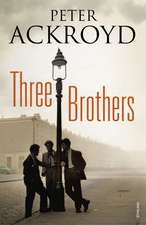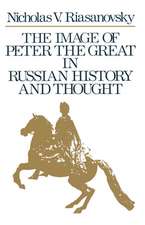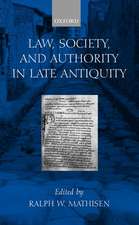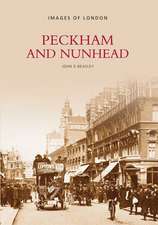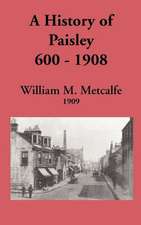Thames: The Biography
Autor Peter Ackroyden Limba Engleză Paperback – 31 oct 2009
Preț: 129.97 lei
Nou
Puncte Express: 195
Preț estimativ în valută:
24.89€ • 25.64$ • 20.88£
24.89€ • 25.64$ • 20.88£
Carte indisponibilă temporar
Doresc să fiu notificat când acest titlu va fi disponibil:
Se trimite...
Preluare comenzi: 021 569.72.76
Specificații
ISBN-13: 9780307389848
ISBN-10: 0307389847
Pagini: 481
Ilustrații: 16 PP COLOR/16 PP B&W/4 MAPS
Dimensiuni: 160 x 236 x 27 mm
Greutate: 0.69 kg
Editura: Anchor Books
ISBN-10: 0307389847
Pagini: 481
Ilustrații: 16 PP COLOR/16 PP B&W/4 MAPS
Dimensiuni: 160 x 236 x 27 mm
Greutate: 0.69 kg
Editura: Anchor Books
Notă biografică
PETER ACKROYD is the author of London: The Biography, Albion: The Origins of the English Imagination, and Shakespeare: The Biography; acclaimed biographies of T.S. Eliot, Dickens, Blake, and Sir Thomas More; thirteen novels; and the series Ackroyd’s Brief Lives. He has won the Whitbread Book Award for Biography, the Royal Society of Literature’s William Heinemann Award, the James Tait Black Memorial Prize, the Guardian Fiction Prize, the Somerset Maugham Award, and the South Bank Award for Literature. He lives in London.
Extras
CHAPTER I
The River as Fact
It has a length of 215 miles, and is navigable for 191 miles. It is the longest river in England but not in Britain, where the Severn is longer by approximately 5 miles. Nevertheless it must be the shortest river in the world to acquire such a famous history. The Amazon and the Mississippi cover almost 4,000 miles, and the Yangtze almost 3,500 miles; but none of them has arrested the attention of the world in the manner of the Thames.
It runs along the borders of nine English counties, thus reaffirming its identity as a boundary and as a defence. It divides Wiltshire from Gloucestershire, and Oxfordshire from Berkshire; as it pursues its way it divides Surrey from Middlesex (or Greater London as it is inelegantly known) and Kent from Essex. It is also a border of Buckinghamshire. It guarded these once tribal lands in the distant past, and will preserve them into the imaginable future.
There are 134 bridges along the length of the Thames, and forty-four locks above Teddington. There are approximately twenty major tributaries still flowing into the main river, while others such as the Fleet have now disappeared under the ground. Its "basin," the area from which it derives its water from rain and other natural forces, covers an area of some 5,264 square miles. And then there are the springs, many of them in the woods or close to the streams beside the Thames. There is one in the wood below Sinodun Hills in Oxfordshire, for example, which has been described as an "everlasting spring" always fresh and always renewed.
The average flow of the river at Teddington, chosen because it marks the place where the tidal and non-tidal waters touch, has been calculated at 1,145 millions of gallons (5,205 millions of litres) each day or approximately 2,000 cubic feet (56.6 cubic metres) per second. The current moves at a velocity between 1Ú2 and 23Ú4 miles per hour. The main thrust of the river flow is known to hydrologists as the "thalweg"; it does not move in a straight and forward line but, mingling with the inner flow and the variegated flow of the surface and bottom waters, takes the form of a spiral or helix. More than 95 per cent of the river's energy is lost in turbulence and friction.
The direction of the flow of the Thames is therefore quixotic. It might be assumed that it would move eastwards, but it defies any simple prediction. It flows north-west above Henley and at Teddington, west above Abingdon, south from Cookham and north above Marlow and Kingston. This has to do with the variegated curves of the river. It does not meander like the Euphrates, where according to Herodotus the voyager came upon the same village three times on three separate days, but it is circuitous. It specialises in loops. It will take the riparian traveller two or three times as long to cover the same distance as a companion on the high road. So the Thames teaches you to take time, and to view the world from a different vantage.
The average "fall" or decline of the river from its beginning to its end is approximately 17 to 21 inches (432 to 533 mm) per mile. It follows gravity, and seeks out perpetually the simplest way to the sea. It falls some 600 feet (183 m) from source to sea, with a relatively precipitous decline of 300 feet (91.5 m) in the first 9 miles; it falls 100 (30.4 m) more in the next 11 miles, with a lower average for the rest of its course. Yet averages may not be so important. They mask the changeability and idiosyncrasy of the Thames. The mean width of the river is given as 1,000 feet (305 m), and a mean depth of 30 feet (9 m); but the width varies from 1 or 2 feet (0.3 to 0.6 m) at Trewsbury to 51Ú2 miles at the Nore.
The tide, in the words of Tennyson, is that which "moving seems asleep, too full for sound and foam." On its flood inward it can promise benefit or danger; on its ebb seaward it suggests separation or adventure. It is one general movement but it comprises a thousand different streams and eddies; there are opposing streams, and high water is not necessarily the same thing as high tide. The water will sometimes begin to fall before the tide is over. The average speed of the tide lies between 1 and 3 knots (1.15 and 3.45 miles per hour), but at times of very high flow it can reach 7 knots (8 miles per hour). At London Bridge the flood tide runs for almost six hours, while the ebb tide endures for six hours and thirty minutes. The tides are much higher now than at other times in the history of the Thames. There can now be a difference of some 24 feet (7.3 m) between high and low tides, although the average rise in the area of London Bridge is between 15 and 22 feet (4.5 and 6.7 m). In the period of the Roman occupation, it was a little over 3 feet (0.9 m). The high tide, in other words, has risen greatly over a period of two thousand years.
The reason is simple. The south-east of England is sinking slowly into the water at the rate of approximately 12 inches (305 mm) per century. In 4000 BC the land beside the Thames was 46 feet (14 m) higher than it is now, and in 3000 BC it was some 31 feet (9.4 m) higher. When this is combined with the water issuing from the dissolution of the polar ice-caps, the tides moving up the lower reaches of the Thames are increasing at a rate of 2 feet (0.6 m) per century. That is why the recently erected Thames Barrier will not provide protection enough, and another barrier is being proposed.
The tide of course changes in relation to the alignment of earth, moon and sun. Every two weeks the high "spring" tides reach their maximum two days after a full moon, while the low "neap" tides occur at the time of the half-moon. The highest tides occur at the times of equinox; this is the period of maximum danger for those who live and work by the river. The spring tides of late autumn and early spring are also hazardous. It is no wonder that the earliest people by the Thames venerated and propitiated the river.
The general riverscape of the Thames is varied without being in any sense spectacular, the paraphernalia of life ancient and modern clustering around its banks. It is in large part now a domesticated river, having been tamed and controlled by many generations. It is in that sense a piece of artifice, with some of its landscape deliberately planned to blend with the course of the water. It would be possible to write the history of the Thames as a history of a work of art.
It is a work still in slow progress. The Thames has taken the same course for ten thousand years, after it had been nudged southward by the glaciation of the last ice age. The British and Roman earthworks by the Sinodun Hills still border the river, as they did two thousand years before. Given the destructive power of the moving waters, this is a remarkable fact. Its level has varied over the millennia--there is a sudden and unexpected rise at the time of the Anglo-Saxon settlement, for example--and the discovery of submerged forests testifies to incidents of overwhelming flood. Its appearance has of course also altered, having only recently taken the form of a relatively deep and narrow channel, but its persistence and identity through time are an aspect of its power.
Yet of course every stretch has its own character and atmosphere, and every zone has its own history. Out of oppositions comes energy, out of contrasts beauty. There is the overwhelming difference of water within it, varying from the pure freshwater of the source through the brackish zone of estuarial water to the salty water in proximity to the sea. Given the eddies of the current, in fact, there is rather more salt by the Essex shore than by the Kentish shore. There are manifest differences between the riverine landscapes of Lechlade and of Battersea, of Henley and of Gravesend; the upriver calm is in marked contrast to the turbulence of the long stretches known as River of London and then London River. After New Bridge the river becomes wider and deeper, in anticipation of its change.
The rural landscape itself changes from flat to wooded in rapid succession, and there is a great alteration in the nature of the river from the cultivated fields of Dorchester to the thick woods of Cliveden. From Godstow the river becomes a place of recreation, breezy and jaunty with the skiffs and the punts, the sports in Port Meadow and the picnic parties on the banks by Binsey. But then by some change of light it becomes dark green, surrounded by vegetation like a jungle river; and then the traveller begins to see the dwellings of Oxford, and the river changes again. Oxford is a pivotal point. From there you can look upward and consider the quiet source; or you can look downstream and contemplate the coming immensity of London.
In the reaches before Lechlade the water makes its way through isolated pastures; at Wapping and Rotherhithe the dwellings seem to drop into it, as if overwhelmed by numbers. The elements of rusticity and urbanity are nourished equally by the Thames. That is why parts of the river induce calm and forgetfulness, and others provoke anxiety and despair. It is the river of dreams, but it is also the river of suicide. It has been called liquid history because within itself it dissolves and carries all epochs and generations. They ebb and flow like water.
CHAPTER 2
The River as Metaphor
The river runs through the language, and we speak of its influence in every conceivable context. It is employed to characterise life and death, time and destiny; it is used as a metaphor for continuity and dissolution, for intimacy and transitoriness, for art and history, for poetry itself. In The Principles of Psychology (1890) William James first coined the phrase "stream of consciousness" in which "every definite image of the mind is steeped . . . in the free water that flows around it." Thus "it flows" like the river itself. Yet the river is also a token of the unconscious, with its suggestion of depth and invisible life.
The river is a symbol of eternity, in its unending cycle of movement and change. It is one of the few such symbols that can readily be understood, or appreciated, and in the continuing stream the mind or soul can begin to contemplate its own possible immortality.
In the poetry of John Denham's "Cooper's Hill" (1642), the Thames is a metaphor for human life. How slight its beginning, how confident its continuing course, how ineluctable its destination within the great ocean:
Hasting to pay his tribute to the sea,
Like mortal life to meet eternity.
The poetry of the Thames has always emphasised its affiliations with human purpose and with human realities. So the personality of the river changes in the course of its journey from the purity of its origins to the broad reaches of the commercial world. The river in its infancy is undefiled, innocent and clear. By the time it is closely pent in by the city, it has become dank and foul, defiled by greed and speculation. In this regress it is the paradigm of human life and of human history. Yet the river has one great advantage over its metaphoric companions. It returns to its source, and its corruption can be reversed. That is why baptism was once instinctively associated with the river. The Thames has been an emblem of redemption and of renewal, of the hope of escaping from time itself.
When Wordsworth observed the river at low tide, with the vista of the "mighty heart" of London "lying still," he used the imagery of human circulation. It is the image of the river as blood, pulsing through the veins and arteries of its terrain, without which the life of London would seize up. Sir Walter Raleigh, contemplating the Thames from the walk by his cell in the Tower, remarked that the "blood which disperseth itself by the branches or veins through all the body, may be resembled to these waters which are carried by brooks and rivers overall the earth." He wrote his History of the World (1610) from his prison cell, and was deeply imbued with the current of the Thames as a model of human destiny. It has been used as the symbol for the unfolding of events in time, and carries the burden of past events upon its back. For Raleigh the freight of time grew ever more complex and wearisome as it proceeded from its source; human life had become darker and deeper, less pure and more susceptible to the tides of affairs. There was one difference Raleigh noticed in his history, when he declared that "for this tide of man's life, after it once turneth and declineth, ever runneth with a perpetual ebb and falling stream, but never floweth again."
The Thames has also been understood as a mirror of morality. The bending rushes and the yielding willows afford lessons in humility and forbearance; the humble weeds along its banks have been praised for their lowliness and absence of ostentation. And who has ventured upon the river without learning the value of patience, of endurance, and of vigilance? John Denham makes the Thames the subject of native discourse in a further sense:
Though deep, yet clear; though gentle, yet not dull;
Strong without rage; without o'erflowing, full.
This suggests that the river represents an English measure, an aesthetic harmony to be sought or wished for, but in the same breath Denham seems to be adverting to some emblem of Englishness itself. The Thames is a metaphor for the country through which it runs. It is modest and moderate, calm and resourceful; it is powerful without being fierce. It is not flamboyantly impressive. It is large without being too vast. It eschews extremes. It weaves its own course without artificial diversions or interventions. It is useful for all manner of purposes. It is a practical river.
When Robert Menzies, an erstwhile Australian prime minister, was taken to Runnymede he was moved to comment upon the "secret springs" of the "slow English character." This identification of the land with the people, the characteristics of the earth and water with the temperament of their inhabitants, remains a poignant one. There is an inward and intimate association between the river and those who live beside it, even if that association cannot readily be understood.
From the Hardcover edition.
The River as Fact
It has a length of 215 miles, and is navigable for 191 miles. It is the longest river in England but not in Britain, where the Severn is longer by approximately 5 miles. Nevertheless it must be the shortest river in the world to acquire such a famous history. The Amazon and the Mississippi cover almost 4,000 miles, and the Yangtze almost 3,500 miles; but none of them has arrested the attention of the world in the manner of the Thames.
It runs along the borders of nine English counties, thus reaffirming its identity as a boundary and as a defence. It divides Wiltshire from Gloucestershire, and Oxfordshire from Berkshire; as it pursues its way it divides Surrey from Middlesex (or Greater London as it is inelegantly known) and Kent from Essex. It is also a border of Buckinghamshire. It guarded these once tribal lands in the distant past, and will preserve them into the imaginable future.
There are 134 bridges along the length of the Thames, and forty-four locks above Teddington. There are approximately twenty major tributaries still flowing into the main river, while others such as the Fleet have now disappeared under the ground. Its "basin," the area from which it derives its water from rain and other natural forces, covers an area of some 5,264 square miles. And then there are the springs, many of them in the woods or close to the streams beside the Thames. There is one in the wood below Sinodun Hills in Oxfordshire, for example, which has been described as an "everlasting spring" always fresh and always renewed.
The average flow of the river at Teddington, chosen because it marks the place where the tidal and non-tidal waters touch, has been calculated at 1,145 millions of gallons (5,205 millions of litres) each day or approximately 2,000 cubic feet (56.6 cubic metres) per second. The current moves at a velocity between 1Ú2 and 23Ú4 miles per hour. The main thrust of the river flow is known to hydrologists as the "thalweg"; it does not move in a straight and forward line but, mingling with the inner flow and the variegated flow of the surface and bottom waters, takes the form of a spiral or helix. More than 95 per cent of the river's energy is lost in turbulence and friction.
The direction of the flow of the Thames is therefore quixotic. It might be assumed that it would move eastwards, but it defies any simple prediction. It flows north-west above Henley and at Teddington, west above Abingdon, south from Cookham and north above Marlow and Kingston. This has to do with the variegated curves of the river. It does not meander like the Euphrates, where according to Herodotus the voyager came upon the same village three times on three separate days, but it is circuitous. It specialises in loops. It will take the riparian traveller two or three times as long to cover the same distance as a companion on the high road. So the Thames teaches you to take time, and to view the world from a different vantage.
The average "fall" or decline of the river from its beginning to its end is approximately 17 to 21 inches (432 to 533 mm) per mile. It follows gravity, and seeks out perpetually the simplest way to the sea. It falls some 600 feet (183 m) from source to sea, with a relatively precipitous decline of 300 feet (91.5 m) in the first 9 miles; it falls 100 (30.4 m) more in the next 11 miles, with a lower average for the rest of its course. Yet averages may not be so important. They mask the changeability and idiosyncrasy of the Thames. The mean width of the river is given as 1,000 feet (305 m), and a mean depth of 30 feet (9 m); but the width varies from 1 or 2 feet (0.3 to 0.6 m) at Trewsbury to 51Ú2 miles at the Nore.
The tide, in the words of Tennyson, is that which "moving seems asleep, too full for sound and foam." On its flood inward it can promise benefit or danger; on its ebb seaward it suggests separation or adventure. It is one general movement but it comprises a thousand different streams and eddies; there are opposing streams, and high water is not necessarily the same thing as high tide. The water will sometimes begin to fall before the tide is over. The average speed of the tide lies between 1 and 3 knots (1.15 and 3.45 miles per hour), but at times of very high flow it can reach 7 knots (8 miles per hour). At London Bridge the flood tide runs for almost six hours, while the ebb tide endures for six hours and thirty minutes. The tides are much higher now than at other times in the history of the Thames. There can now be a difference of some 24 feet (7.3 m) between high and low tides, although the average rise in the area of London Bridge is between 15 and 22 feet (4.5 and 6.7 m). In the period of the Roman occupation, it was a little over 3 feet (0.9 m). The high tide, in other words, has risen greatly over a period of two thousand years.
The reason is simple. The south-east of England is sinking slowly into the water at the rate of approximately 12 inches (305 mm) per century. In 4000 BC the land beside the Thames was 46 feet (14 m) higher than it is now, and in 3000 BC it was some 31 feet (9.4 m) higher. When this is combined with the water issuing from the dissolution of the polar ice-caps, the tides moving up the lower reaches of the Thames are increasing at a rate of 2 feet (0.6 m) per century. That is why the recently erected Thames Barrier will not provide protection enough, and another barrier is being proposed.
The tide of course changes in relation to the alignment of earth, moon and sun. Every two weeks the high "spring" tides reach their maximum two days after a full moon, while the low "neap" tides occur at the time of the half-moon. The highest tides occur at the times of equinox; this is the period of maximum danger for those who live and work by the river. The spring tides of late autumn and early spring are also hazardous. It is no wonder that the earliest people by the Thames venerated and propitiated the river.
The general riverscape of the Thames is varied without being in any sense spectacular, the paraphernalia of life ancient and modern clustering around its banks. It is in large part now a domesticated river, having been tamed and controlled by many generations. It is in that sense a piece of artifice, with some of its landscape deliberately planned to blend with the course of the water. It would be possible to write the history of the Thames as a history of a work of art.
It is a work still in slow progress. The Thames has taken the same course for ten thousand years, after it had been nudged southward by the glaciation of the last ice age. The British and Roman earthworks by the Sinodun Hills still border the river, as they did two thousand years before. Given the destructive power of the moving waters, this is a remarkable fact. Its level has varied over the millennia--there is a sudden and unexpected rise at the time of the Anglo-Saxon settlement, for example--and the discovery of submerged forests testifies to incidents of overwhelming flood. Its appearance has of course also altered, having only recently taken the form of a relatively deep and narrow channel, but its persistence and identity through time are an aspect of its power.
Yet of course every stretch has its own character and atmosphere, and every zone has its own history. Out of oppositions comes energy, out of contrasts beauty. There is the overwhelming difference of water within it, varying from the pure freshwater of the source through the brackish zone of estuarial water to the salty water in proximity to the sea. Given the eddies of the current, in fact, there is rather more salt by the Essex shore than by the Kentish shore. There are manifest differences between the riverine landscapes of Lechlade and of Battersea, of Henley and of Gravesend; the upriver calm is in marked contrast to the turbulence of the long stretches known as River of London and then London River. After New Bridge the river becomes wider and deeper, in anticipation of its change.
The rural landscape itself changes from flat to wooded in rapid succession, and there is a great alteration in the nature of the river from the cultivated fields of Dorchester to the thick woods of Cliveden. From Godstow the river becomes a place of recreation, breezy and jaunty with the skiffs and the punts, the sports in Port Meadow and the picnic parties on the banks by Binsey. But then by some change of light it becomes dark green, surrounded by vegetation like a jungle river; and then the traveller begins to see the dwellings of Oxford, and the river changes again. Oxford is a pivotal point. From there you can look upward and consider the quiet source; or you can look downstream and contemplate the coming immensity of London.
In the reaches before Lechlade the water makes its way through isolated pastures; at Wapping and Rotherhithe the dwellings seem to drop into it, as if overwhelmed by numbers. The elements of rusticity and urbanity are nourished equally by the Thames. That is why parts of the river induce calm and forgetfulness, and others provoke anxiety and despair. It is the river of dreams, but it is also the river of suicide. It has been called liquid history because within itself it dissolves and carries all epochs and generations. They ebb and flow like water.
CHAPTER 2
The River as Metaphor
The river runs through the language, and we speak of its influence in every conceivable context. It is employed to characterise life and death, time and destiny; it is used as a metaphor for continuity and dissolution, for intimacy and transitoriness, for art and history, for poetry itself. In The Principles of Psychology (1890) William James first coined the phrase "stream of consciousness" in which "every definite image of the mind is steeped . . . in the free water that flows around it." Thus "it flows" like the river itself. Yet the river is also a token of the unconscious, with its suggestion of depth and invisible life.
The river is a symbol of eternity, in its unending cycle of movement and change. It is one of the few such symbols that can readily be understood, or appreciated, and in the continuing stream the mind or soul can begin to contemplate its own possible immortality.
In the poetry of John Denham's "Cooper's Hill" (1642), the Thames is a metaphor for human life. How slight its beginning, how confident its continuing course, how ineluctable its destination within the great ocean:
Hasting to pay his tribute to the sea,
Like mortal life to meet eternity.
The poetry of the Thames has always emphasised its affiliations with human purpose and with human realities. So the personality of the river changes in the course of its journey from the purity of its origins to the broad reaches of the commercial world. The river in its infancy is undefiled, innocent and clear. By the time it is closely pent in by the city, it has become dank and foul, defiled by greed and speculation. In this regress it is the paradigm of human life and of human history. Yet the river has one great advantage over its metaphoric companions. It returns to its source, and its corruption can be reversed. That is why baptism was once instinctively associated with the river. The Thames has been an emblem of redemption and of renewal, of the hope of escaping from time itself.
When Wordsworth observed the river at low tide, with the vista of the "mighty heart" of London "lying still," he used the imagery of human circulation. It is the image of the river as blood, pulsing through the veins and arteries of its terrain, without which the life of London would seize up. Sir Walter Raleigh, contemplating the Thames from the walk by his cell in the Tower, remarked that the "blood which disperseth itself by the branches or veins through all the body, may be resembled to these waters which are carried by brooks and rivers overall the earth." He wrote his History of the World (1610) from his prison cell, and was deeply imbued with the current of the Thames as a model of human destiny. It has been used as the symbol for the unfolding of events in time, and carries the burden of past events upon its back. For Raleigh the freight of time grew ever more complex and wearisome as it proceeded from its source; human life had become darker and deeper, less pure and more susceptible to the tides of affairs. There was one difference Raleigh noticed in his history, when he declared that "for this tide of man's life, after it once turneth and declineth, ever runneth with a perpetual ebb and falling stream, but never floweth again."
The Thames has also been understood as a mirror of morality. The bending rushes and the yielding willows afford lessons in humility and forbearance; the humble weeds along its banks have been praised for their lowliness and absence of ostentation. And who has ventured upon the river without learning the value of patience, of endurance, and of vigilance? John Denham makes the Thames the subject of native discourse in a further sense:
Though deep, yet clear; though gentle, yet not dull;
Strong without rage; without o'erflowing, full.
This suggests that the river represents an English measure, an aesthetic harmony to be sought or wished for, but in the same breath Denham seems to be adverting to some emblem of Englishness itself. The Thames is a metaphor for the country through which it runs. It is modest and moderate, calm and resourceful; it is powerful without being fierce. It is not flamboyantly impressive. It is large without being too vast. It eschews extremes. It weaves its own course without artificial diversions or interventions. It is useful for all manner of purposes. It is a practical river.
When Robert Menzies, an erstwhile Australian prime minister, was taken to Runnymede he was moved to comment upon the "secret springs" of the "slow English character." This identification of the land with the people, the characteristics of the earth and water with the temperament of their inhabitants, remains a poignant one. There is an inward and intimate association between the river and those who live beside it, even if that association cannot readily be understood.
From the Hardcover edition.
Recenzii
"Thames smells authentically of the water, of an author who has walked the towpath and knows not only the impressive statistics…but also the Turner water-colours of the Thames itself…. It is not just the subject that sets this book apart but also the compelling new perspectives that [Ackroyd] brings." —The Times
“The pages glint with scintillating nuggets recovered from the river…. You might well think that the garlanded biographer of Dickens and Turner was born to write this extraordinary book.” —The Observer
“Mesmerising. . . As soon as you open this account of the Thames, you will want to immerse yourself in it. . . . No one is better than Ackroyd at evoking the texture and atmosphere of the distant past.” —Daily Telegraph
“An unmissable performance.” —The Guardian
"[A book of] substance and unflaggingly interesting detail. . . a very enjoyable and highly idiosyncratic account of the subject." —The Spectator
“Wonderful…. Peter Ackroyd’s writing is such a pleasure that Thames can be read all at once, with increasing delight, and afterwards dipped into, like stretches of the great waterway it charts and celebrates.” —Financial Times Magazine
“[Ackroyd’s] exhaustive reclaiming of the Thames inks in colourful new detail. —TIME
“a rich offering by a masterly writer…” —Times Literary Supplement
“[Ackroyd] presents his material as a cornucopia of treats and insights delivered from all directions.” —The Independent
“The pages glint with scintillating nuggets recovered from the river…. You might well think that the garlanded biographer of Dickens and Turner was born to write this extraordinary book.” —The Observer
“Mesmerising. . . As soon as you open this account of the Thames, you will want to immerse yourself in it. . . . No one is better than Ackroyd at evoking the texture and atmosphere of the distant past.” —Daily Telegraph
“An unmissable performance.” —The Guardian
"[A book of] substance and unflaggingly interesting detail. . . a very enjoyable and highly idiosyncratic account of the subject." —The Spectator
“Wonderful…. Peter Ackroyd’s writing is such a pleasure that Thames can be read all at once, with increasing delight, and afterwards dipped into, like stretches of the great waterway it charts and celebrates.” —Financial Times Magazine
“[Ackroyd’s] exhaustive reclaiming of the Thames inks in colourful new detail. —TIME
“a rich offering by a masterly writer…” —Times Literary Supplement
“[Ackroyd] presents his material as a cornucopia of treats and insights delivered from all directions.” —The Independent
Descriere
Descriere de la o altă ediție sau format:
Just as Peter Ackroyd's bestselling London is the biography of the city, Thames: Sacred River is the biography of the river, from sea to source.
Just as Peter Ackroyd's bestselling London is the biography of the city, Thames: Sacred River is the biography of the river, from sea to source.





